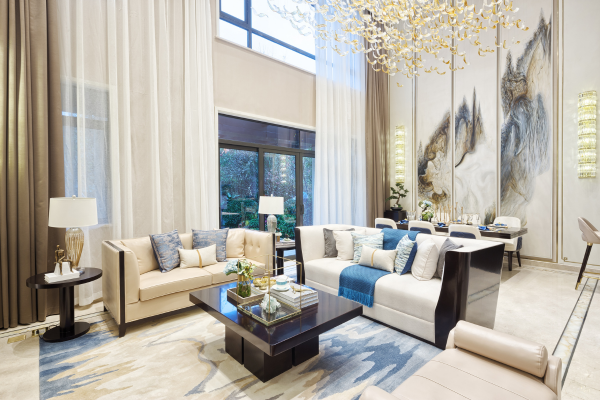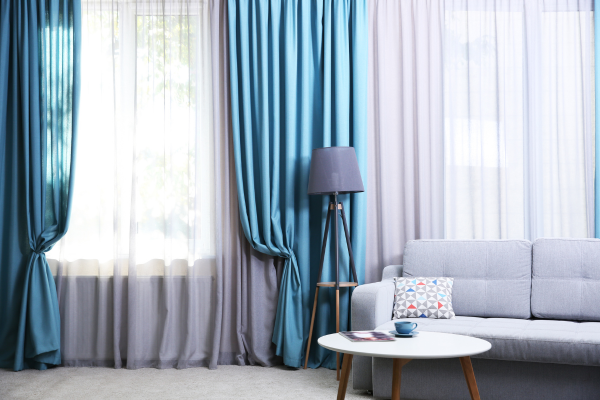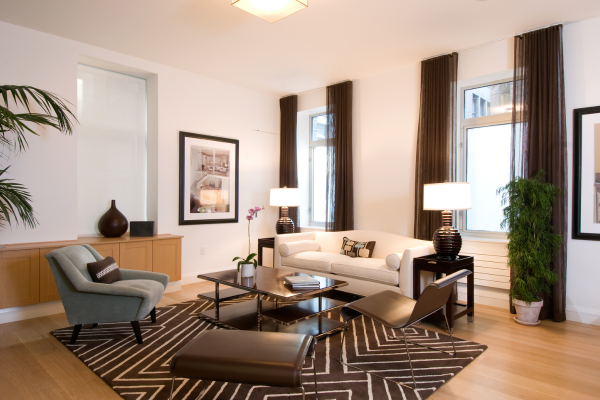Simple living room curtain ideas can transform your space from mundane to magnificent. Curtains not only serve practical purposes like light control and privacy but also add depth and personality to your living area. In this guide, we’ll explore various curtain styles, fabrics, And design tips to help you create a cozy and inviting ambiance in your living room.
What defines simple living room curtain ideas?

Simple living room curtain ideas emphasize minimalist design principles while maximizing functionality and aesthetic appeal. These ideas prioritize clean lines, understated elegance, And practicality, ensuring that your curtains enhance the overall look and feel of your living space without overwhelming it.
Importance of curtains in interior design

Curtains play a crucial role in interior design by softening harsh lines, adding texture, and creating visual interest. They also contribute to the ambiance of a room by controlling light levels, enhancing privacy, and tying together the decor scheme. With the right curtain choices, you can elevate the style and comfort of your living room effortlessly.
Choosing the Right Fabric

Selecting the perfect fabric for your simple living room curtains is essential for achieving the desired aesthetic and functionality.
Fabrics suitable for simple living room curtains
When choosing fabrics for your living room curtains, opt for lightweight materials like linen, cotton, or polyester blends. These fabrics offer a balance of durability, breathability, and easy maintenance, making them ideal for everyday use in a busy living space. Additionally, consider the opacity of the fabric; sheer fabrics allow diffused light to enter the room, while thicker fabrics provide more privacy and light control.
Considerations for fabric durability and maintenance
When selecting curtain fabrics, prioritize durability and ease of maintenance. Look for fabrics that are machine washable or can be easily spot-cleaned to keep them looking fresh and vibrant. Additionally, consider factors like colorfastness and shrinkage resistance to ensure that your curtains maintain their appearance over time.
Color and Pattern Selection

The color and pattern of your curtains can significantly impact the overall look and feel of your living room.
Neutral vs. bold colors
Neutral colors like white, beige, or gray create a timeless and sophisticated look that complements a wide range of interior styles. On the other hand, bold colors such as deep blues, rich greens, or warm reds can add drama and personality to your living room decor. Choose colors that harmonize with your existing color palette and reflect your personal taste and style.
Patterns that complement minimalist living spaces
For a minimalist aesthetic, opt for curtains with subtle patterns or textures that add visual interest without overwhelming the space. Geometric patterns, delicate stripes, or simple botanical prints can infuse personality into your living room while maintaining a clean and uncluttered look. Avoid busy or intricate patterns that may detract from the simplicity of your design.
Curtain Length and Width

Getting the dimensions right is crucial for achieving a polished look with your living room curtains.
Optimal length for simple living room curtains
curtain length guide, floor-length curtains
Choose curtains that extend to the floor or skim the floor for a classic and elegant look. Floor-length curtains create a sense of height and grandeur, making your living room feel more spacious and luxurious. Avoid curtains that are too short, as they can make the room appear smaller and incomplete.
Width considerations for different window sizes
curtain width calculation, measuring window width
When determining the width of your curtains, ensure that they can fully cover the width of your windows when closed. To achieve a full and lush appearance when the curtains are open, multiply the width of your window by 1.5 to 2 times. This extra fabric allows the curtains to gather gracefully when drawn back, creating a soft and romantic look.
Curtain Styles

Explore different curtain styles to find the perfect fit for your living room decor.
Rod pocket vs. grommet curtains
Rod pocket curtains feature a casing at the top that allows a curtain rod to be threaded through, creating a gathered effect. Grommet curtains, on the other hand, have metal rings punched along the top edge, which slide directly onto the curtain rod for a sleek and modern look. Consider the style of your living room and the functionality you desire when choosing between these two options.
Sheer curtains for a light and breezy feel
Sheer curtains are an excellent choice for adding a soft and ethereal ambiance to your living room. These lightweight fabrics allow natural light to filter through while providing a degree of privacy and diffusion. Sheer curtains are perfect for creating a cozy and inviting atmosphere, especially in rooms with limited natural light.
Hardware and Accessories

Choosing the right hardware and accessories can enhance the functionality and visual appeal of your living room curtains.
Curtain rods and finials
decorative curtain rods, finial styles
Select curtain rods that complement your living room decor style, whether it’s traditional, modern, or eclectic. Opt for decorative finials to add a touch of elegance and personality to your window treatments. Additionally, ensure that the curtain rods are sturdy enough to support the weight of your curtains without sagging or bending.
Tiebacks and holdbacks for added functionality
curtain tieback options, holdback placement
Tiebacks and holdbacks not only add a decorative element to your curtains but also serve a practical purpose by keeping them neatly in place when open. Choose tiebacks that coordinate with your curtain rods and finials for a cohesive look. Position holdbacks strategically to create elegant swags or cascading folds in your curtains.
Layering Curtains

Layering curtains adds depth, texture, and versatility to your living room decor.
Mixing sheer and opaque curtains for versatility
curtain layering techniques, sheer and blackout combinations
Layer sheer curtains over opaque ones to create a dynamic interplay of light and shadow in your living room. This combination allows you to control the amount of natural light entering the room while maintaining privacy and ambiance. Experiment with different fabric textures and colors to achieve the perfect balance of functionality and style.
Benefits of layering curtains in a living room
layered curtain advantages, window treatment versatility
Layering curtains not only enhances the aesthetic appeal of your living room but also offers practical benefits. By combining sheer and opaque curtains, you can customize your window treatments to suit different times of the day and changing seasons. Layered curtains also provide additional insulation, helping to regulate temperature and reduce energy costs.
Light Control and Privacy

Achieving the right balance between natural light and privacy is essential for creating a comfortable living room environment.
Balancing natural light with privacy needs
Natural light in living rooms, privacy window treatments
Consider the orientation of your windows and the amount of natural light they receive throughout the day. Opt for curtains with adjustable features like tiebacks or blinds that allow you to control the amount of light entering the room. Sheer curtains are an excellent choice for maximizing natural light while maintaining a degree of privacy.
Blackout options for enhanced privacy and sleep
blackout curtain benefits, light-blocking window treatments
If privacy and light control are top priorities, consider investing in blackout curtains for your living room. These opaque window treatments effectively block out sunlight, streetlights, and noise, creating a peaceful and restful environment for relaxation and sleep. Choose blackout curtains with thermal insulation properties to improve energy efficiency and room comfort.
Maintenance and Cleaning Tips

Proper care and maintenance are essential for preserving the beauty and functionality of your living room curtains.
Routine care for simple living room curtains
curtain care tips, maintaining fabric integrity
Regularly vacuum or dust your curtains to remove surface debris and prevent dust buildup. For fabric curtains, spot clean any stains promptly using a mild detergent and cold water. Avoid using harsh chemicals or bleach, as they can damage the fabric and affect its colorfastness. Additionally, periodically rotate or flip your curtains to ensure even sun exposure and prevent fading.
Cleaning methods for different fabric types
curtain cleaning techniques, fabric-specific care
Refer to the manufacturer’s care instructions for specific cleaning recommendations based on the type of fabric used in your curtains. Machine-washable fabrics like cotton and polyester blends can be laundered on a gentle cycle with mild detergent. Dry clean delicate or embellished curtains to avoid damage to intricate details. For stubborn stains or odors, consider professional cleaning services for optimal results.
DIY Curtain Ideas

Get creative and personalize your living room curtains with these easy DIY projects.
Simple sewing projects for custom curtain designs
DIY curtain sewing, handmade window treatments
If you enjoy sewing, consider making your own curtains using fabric that complements your living room decor. Choose a simple sewing pattern for beginners, such as rod pocket or tab top curtains, and customize the length and width to fit your windows perfectly. Adding decorative trims, like pom-poms or tassels, can elevate the look of your homemade curtains.
No-sew options for quick and budget-friendly curtains
DIY no-sew curtains, fabric adhesive techniques
For those who prefer a no-sew approach, there are plenty of options for creating stylish curtains without touching a needle and thread. Use fabric adhesive tape or iron-on hemming tape to create clean and polished edges without sewing. You can also repurpose items like bedsheets or tablecloths into curtains by hemming the edges and adding curtain rings or clips for hanging.
Budget-Friendly Curtain Solutions

Achieve the look you want without breaking the bank with these affordable curtain alternatives.
Affordable curtain alternatives
budget-friendly window treatments, and economical curtain options
Explore budget-friendly alternatives to traditional curtains, such as fabric shower curtains, drop cloths, or bed sheets. These versatile materials offer a wide range of colors and patterns at a fraction of the cost of designer fabrics. Get creative with your curtain rods by using inexpensive plumbing pipes or wooden dowels for a rustic and industrial look.
Repurposing items for unique curtain designs
upcycled curtain ideas, and eco-friendly window treatments
Think outside the box and repurpose everyday items into one-of-a-kind curtains for your living room. Consider using vintage scarves, lace table runners, or even old sweaters to create eclectic and whimsical window treatments. Not only will you save money, but you’ll also reduce waste and add character to your living space.
Incorporating Greenery with Curtains

Bring the beauty of nature indoors by pairing your curtains with lush greenery.
Using plants to enhance curtain aesthetics
indoor plants with curtains, botanical decor idea
Place potted plants near your windows to complement your curtains and add a touch of greenery to your living room decor. Choose low-maintenance houseplants like pothos, spider plants, or snake plants that thrive in indirect sunlight. Hanging planters or macrame plant hangers can create visual interest and vertical dimension alongside your curtains.
Tips for pairing curtains with indoor plants
Consider the color and texture of your curtains when selecting plants to display nearby. Vibrant green foliage can provide a striking contrast against neutral-colored curtains, while variegated leaves or trailing vines can add visual depth and movement. Experiment with different plant placements and arrangements to find the perfect balance between nature and design.
Professional Consultation

Know when to seek advice from an interior designer for expert guidance on curtain selection.
When seeking advice from an interior designer
professional curtain consultation, interior design expertise
If you’re unsure about which curtains will best suit your living room decor or need help navigating the myriad options available, consider consulting with an interior designer. Design professionals can offer personalized recommendations based on your style preferences, budget constraints, and functional requirements. They can also provide valuable insights into current design trends and industry best practices.
Benefits of professional guidance for curtain selection
Advantages of working with a designer, personalized design solutions
Working with an interior designer can streamline the curtain selection process and ensure that your living room decor reflects your unique personality and lifestyle. Designers have access to a wide range of fabric samples, hardware options, and custom solutions that may not be readily available to the average consumer. Additionally, they can coordinate your curtains with other design elements in your living room, such as furniture, rugs, and accessories, to create a cohesive and harmonious look
.
Cotton, linen, and velvet are popular fabric choices for simple living room curtains due to their durability and versatility.
Opt for sheer or lightweight curtains that allow sunlight to filter through while still providing privacy. Consider installing curtain rods above the window frame to create the illusion of height and openness.
Budget-friendly options include ready-made curtains, thrift store finds, and DIY projects. Shop sales, clearance events, and online marketplaces for affordable curtain options.
Common mistakes include hanging curtains too low, using curtains that are too short for the windows, and neglecting to properly measure for curtain fullness.
Layering curtains is a great way to add depth and dimension to your living room decor. Combine sheer curtains with heavier drapes for a layered look that offers both style and functionality.
